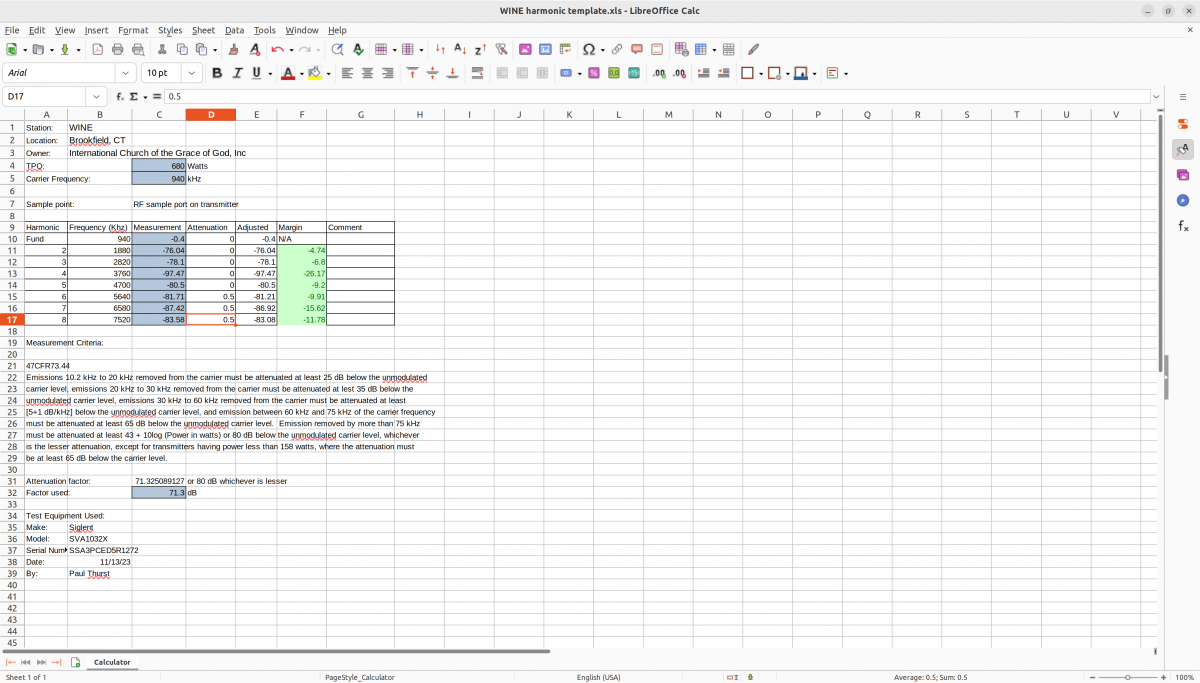I Finished up this installation of a J-1000 in Brookfield, Connecticut for Nossa Radio. That is a Portuguese broadcaster that owns three other stations in the US.

These Nautels are fairly simple affairs; a controller and two RF amps with incumbent power supplies.

Be sure to install the surge suppressor that comes with the transmitter.
The J-1000 is replacing the 43-year-old Harris MW-1A which will function as a backup. Like all new transmitter installations; some things must be done to complete the job.

Harmonic measurements out to about the 5th or 6th harmonic need to be documented and compliant with NRSC-2 (AM mask requirements). Although NRSC-2 measurements are required, I don’t see how they can enforce that specification after AM HD radio came into being. Nevertheless, it was measured and passed. With the station carrier power of 680 watts, I used the RF monitor port on the back of the transmitter to make the measurement. Otherwise, I would need to find an empty field somewhere 1 KM away and stand in the middle of it to reduce all of the electrical noise.

The NRSC-2 mask is mainly a function of High-Frequency limitation in the audio processor—certain transmitters, like the aforementioned MW1A did make some contributions to out-of-tolerance measurements.



The antenna is a skirted tower that has many other services colocated on it. At the top is WRKI.


Driving away from this site, I would have to agree with the predicted contour map above, at least on the highway. I think it may be a bit different driving around in town.







What really amazes me is that you can run all those 1/2″ hardline (well, semi-hardline) runs up the tower AND get the blasted thing to tune up on MF OK. Physics is a wonderful thing, Smith Charts forever!
On another note, when I saw the station call letters on the top of the rack, my first thought was “Wonderful WINO, in Walla Walla, Washington!”. My second was, maybe that was a sign for the engineer working on the transmitter, you need a belt before diving in?
I hope this facility has more security than the one in Alabama did. You know, those illegals will steal ANYTHING.
It’s amazing how things have changed with AM transmitters. While engineering WMMM we had an MW-1 (not the “A” variant) for our main and one of the station’s original RCA BTA-1R as the backup. The late Art Silver from Harris performed a mod for the station’s third power level of 50 watts post-sunset before we’d drop down to 9 watts at night via an LPB transmitter. It’s amazing to see these small, solid state transmitters like the BE AMA1 and the Nautel sharing real estate in the equipment rack instead of major floor space.
All in all, the MW1 was a workhorse. The only time it became cranky on my watch was when a number of tie wraps failed that was holding the hardline for the STL receivers, letting them flap in the breeze. The Harris would mute momentarily while the RCA just chugged along until Pat Allen got a crew to secure the lines. The only other “pain” was having one module that would dimly light the neon lamp inside the transmitter – no amount of matching transistors got the light completely out.
Crusty; several years ago, we moved the MW1A out of the old house that functioned as a transmitter building since the 1950’s. It seems that a previous engineer did indeed enjoy some wine from time to time. We found a 1/2 gallon jug of homemade wine on the file cabinet in his old office. It had long since turned to vinegar.
Lou; the local constabulary has their radio system on the tower. The site is well-watched.
Bill, things have indeed gotten smaller. I will say this MW1A has been reliable over the years. I think it is something like 45 now. They are particular about the load. I had one in Harrisburg PA on City Island. Every year, the city would dump loads of snow on the ground system, which would cause intermittent sputters. I would have to climb over all that snow to touch up the tuning.
Took care of a SS transmitter that ran 5 kw day 600 watts night. The 60 KHz PDM was well within NRSC -+ carrier frequency even at low power at the transmitter sample port. Into the DA at 600 watts and out in the field, they exceed NRSC at several of the major lobes where measurements are taken. You can take NRSC closer then 1 km if needed. The 60 KHz PDM is attenuated well below NRSC in the field at 5 kw non-directional
I didn’t realize WINE was a station Townsquare had sold. and recently, too…judging solely by FCC filings. Was all this fix-up happening on Townsquare’s dime or Nossa Radio’s? I’m assuming the latter. 🙂
How’s the little Radio Systems nighttime transmitter working? With some TLC (and replacing the original heating element…errr…power supply) those old RS or LPB CC-AM transmitters were fabulous nighttime and/or backup transmitters. And +1 on the Optimod 9200. Very nice-sounding boxes. Next time I’m driving by on the Merritt (ugh) I’ll have to tune in!
I believe they were on the verge of surrendering the license if Nossa had not bought it.